Have you ever gazed up at the sky, captivated by the sight of geese flying in their iconic V-formation, only to find yourself equally mesmerized by their distinctive honking? This aerial orchestra has puzzled and fascinated humans for centuries. In this comprehensive exploration, we’ll unravel the mystery behind why geese honk when they fly and delve into the intricate world of goose communication.
The Science of Goose Communication
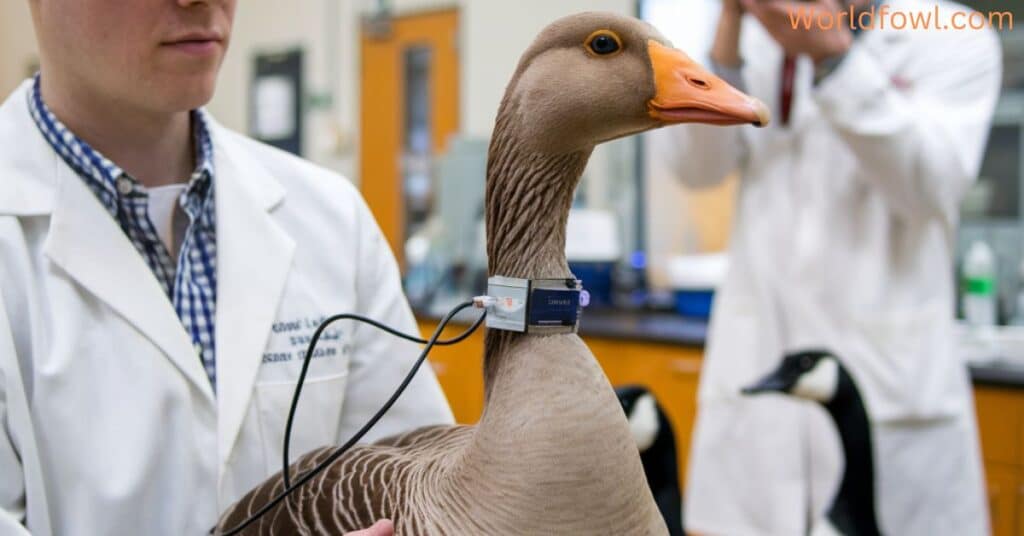
Before we soar into the reasons behind aerial honking, let’s ground ourselves in the basics of how geese communicate.
Vocal Anatomy of Geese
Geese are equipped with a remarkable vocal apparatus that allows them to produce their characteristic honks. Unlike humans, who use their larynx to speak, geese have a unique organ called the syrinx. Located at the base of the trachea, the syrinx enables geese to produce a wide range of vocalizations.
- Syrinx structure: Two-sided organ with independent control
- Sound production: Vibration of tympaniform membranes
- Pitch control: Achieved by altering air pressure and membrane tension
This specialized anatomy allows geese to create their distinctive honking sounds, which can travel long distances – a crucial feature for airborne communication. The syrinx’s two-sided structure even allows geese to produce two different sounds simultaneously, adding complexity to their vocal repertoire.
Types of Calls and Their Meanings
Geese are far from one-note wonders. They have a diverse vocal repertoire, each sound serving a specific purpose:
- Alarm call: A sharp, high-pitched honk to warn of danger
- Contact call: Softer, more melodic honks to maintain group cohesion
- Greeting call: Enthusiastic honking when reuniting with family members
- Triumph call: A celebratory series of honks after warding off a threat
- Distress call: A loud, persistent honk when in trouble or separated from the flock
Understanding these different calls provides insight into the complex social lives of geese and sets the stage for unraveling the mystery of their in-flight honking. Each call type has its own acoustic signature, allowing geese to convey specific information efficiently to their flock mates.
Honking on the Fly: Unraveling the Reasons
Now that we’ve established the foundations of goose communication, let’s explore the specific reasons why geese honk during flight.
The “Follow Me” Call: Leadership in Motion
One of the primary reasons for honking during flight is leadership communication. The lead goose in the V-formation often honks to:
- Signal direction changes
- Encourage the flock to maintain speed
- Indicate the discovery of suitable landing sites
This “follow me” call is crucial for maintaining the integrity of the flock during long migratory journeys. The lead goose takes on a significant responsibility, using its vocalizations to guide the entire flock safely to their destination.
you may also like : Do Geese Fly At Night? How Can They See?
Navigational Chatter: Nature’s GPS System

Geese don’t have the luxury of GPS devices, but they do have an innate navigational system that’s enhanced by vocal communication. Honking geese are often engaged in a form of navigational chatter:
- Sharing information about landmarks
- Alerting the flock to changes in wind patterns
- Communicating about potential rest stops
This constant exchange of information helps the flock navigate efficiently over vast distances. Geese have been observed to recognize and remember geographical features, using them as waypoints during migration. Their honking serves as a way to collectively process and share this navigational information.
Energy Boost: Honking as Motivation
Flying long distances is no easy feat, even for geese. The honking serves as a form of encouragement, much like cheering on marathon runners. This motivational honking:
- Boosts morale during challenging weather conditions
- Encourages tired flock members to keep pace
- Celebrates milestones during the journey
The rhythmic honking can create a sense of unity and purpose within the flock, helping them push through the fatigue of long flights. This vocal encouragement is particularly important during harsh weather conditions or when crossing large bodies of water with no opportunity to rest.
Flock Cohesion: Staying Together in Vast Skies
Imagine trying to keep a group together while traveling through clouds, over mountains, and across vast bodies of water. This is the challenge geese face during migration. Honking plays a crucial role in maintaining flock cohesion:
- Acoustic beacon: Helps stragglers locate the main group
- Position updates: Allows geese to communicate their location within the formation
- Speed coordination: Ensures the flock maintains a consistent pace
By constantly communicating, geese can stay together even when visual cues are limited. This vocal coordination is especially vital during night flights or when navigating through fog or clouds.
Danger Alerts: Airborne Early Warning System
The skies may seem peaceful to us, but they’re full of potential dangers for flying geese. Honking in flight serves as an early warning system:
| Threat Type | Honking Response |
| Predatory birds | Sharp, rapid honks |
| Approaching storms | Low, prolonged honks |
| Aircraft | Erratic, loud honking |
| Obstacles | Quick, repetitive honks |
This aerial alarm system allows the flock to react quickly to potential threats, enhancing their chances of survival during long migrations. The specific patterns of honks can convey detailed information about the nature and location of the threat, allowing the flock to take appropriate evasive action.
The V-Formation: More Than Meets the Eye
The iconic V-formation of flying geese isn’t just visually striking – it’s a marvel of natural engineering that works in tandem with their vocalizations.
Aerodynamics and Energy Conservation
The V-formation serves several crucial purposes:
- Reduced wind resistance: Each bird flies slightly above the bird in front, catching the upwash from its wingtips
- Energy savings: Geese flying in formation use up to 20% less energy than solo flyers
- Increased range: The energy-efficient formation allows for longer non-stop flights
This formation is a testament to the evolutionary adaptations of geese, allowing them to undertake grueling migratory journeys with maximum efficiency.
How Honking Complements This Flight Strategy
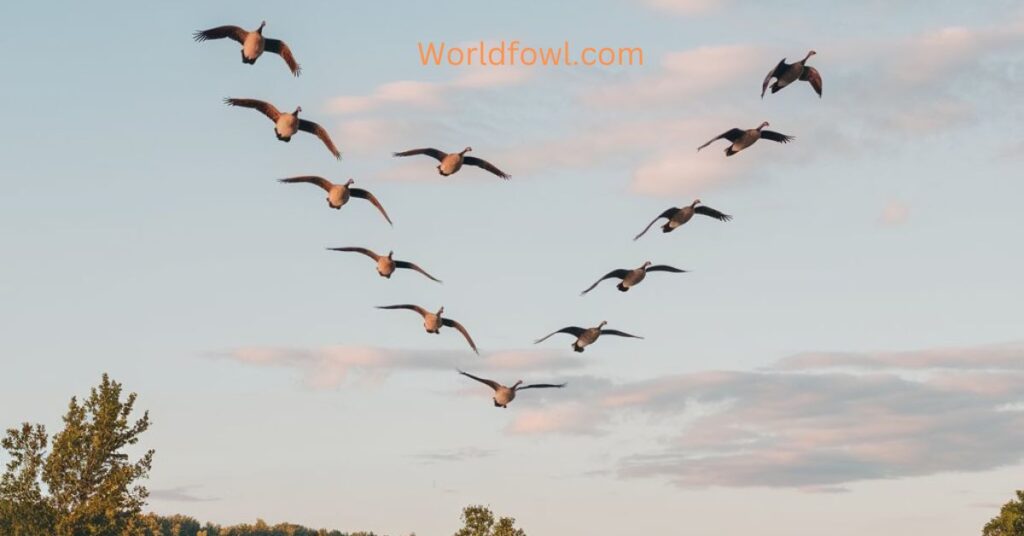
The honking of geese is intrinsically linked to the effectiveness of their V-formation:
- Coordination: Honks help synchronize wing beats and position changes
- Rotation signaling: Indicates when it’s time to rotate the lead position
- Effort communication: Allows geese to signal when they need a break or can take on a more demanding position
This vocal-physical coordination showcases the remarkable adaptations that make geese such successful migratory birds. The honking serves as a real-time communication system that ensures the V-formation remains optimal throughout the flight.
you may also like : How and Where Do Geese Sleep? The Secrets of Goose Slumber
Variations in Aerial Honking
Not all goose honks are created equal. Let’s explore the variations in aerial vocalizations among different species and situations.
Different Species, Different Songs
While we often think of the Canada goose when imagining honking geese, various species have their unique vocal signatures:
- Canada Goose: Deep, resonant “honk”
- Snow Goose: High-pitched, nasal “wink”
- Brant Goose: Guttural “ruk-ruk”
- Greylag Goose: Loud, trumpeting call
These distinct vocalizations help different species identify their own kind, even in mixed flocks. The variations in calls also reflect the different habitats and social structures of each species.
Seasonal Changes in Honking Patterns
The frequency and intensity of goose honking change with the seasons:
- Spring: Increased honking during mating season and nest establishment
- Summer: Quieter periods as geese focus on raising goslings
- Fall: Heightened vocalizations as flocks prepare for migration
- Winter: Varied honking patterns depending on wintering grounds and food availability
Understanding these seasonal variations provides insight into the annual life cycle of geese and how their communication adapts to changing needs. For example, the increased honking in spring serves not only for mating purposes but also to establish and defend nesting territories.
The Solo Flyer’s Cry: Why Lone Geese Honk

Occasionally, you might hear a single goose honking as it flies. This solitary call serves several purposes:
- Reunion attempts: Trying to locate its lost flock
- Distress signal: Indicating injury or disorientation
- Territory announcement: Signaling its presence to other geese in the area
These solo honks remind us that Geese Honk isn’t just about group dynamics – it’s also crucial for individual survival and social interaction. A lone goose is at greater risk from predators and may struggle to navigate efficiently, making its calls particularly urgent and persistent.
Grounded Conversations: Honking on Terra Firma
While our focus has been on aerial honking, geese are equally vocal when on the ground. Let’s explore their terrestrial communications.
Territorial Disputes and Mating Calls
On the ground, honking takes on new significance in social interactions:
- Territorial defense: Loud, aggressive honks to ward off intruders
- Mating rituals: Softer, more melodic honks during courtship displays
- Flock politics: Assertive honks to establish and maintain social hierarchies
These ground-based vocalizations play a crucial role in the complex social lives of Geese Honk . The honking during territorial disputes can be particularly intense, with geese using a combination of vocalizations and physical displays to assert dominance or protect their space.
Warning Signals for Ground-Based Threats
Geese are vigilant guardians, always on the lookout for danger. Their ground-based warning system includes:
- Short, sharp honks to alert nearby geese of immediate threats
- Prolonged, loud honking to signal persistent danger
- Coordinated group honking to intimidate potential predators
This vocal alarm system helps protect not just individual geese, but entire flocks and nesting areas. The coordinated group honking is particularly effective, creating a wall of sound that can deter even large predators.
Family Communication: Goslings and Parents
The gentle honks between parent geese and their goslings are a testament to the strong family bonds in goose society:
- Feeding calls: Soft honks to guide goslings to food sources
- Assembly calls: Louder honks to gather the family when it’s time to move
- Comfort sounds: Quiet, rhythmic honking to soothe and reassure young goslings
These family vocalizations showcase the nurturing side of goose behavior and the importance of communication in geese from an early age. The parent-gosling communication begins even before hatching, with goslings responding to their parents’ calls from inside the egg.
Beyond the Honk: The Goose’s Communication Toolkit
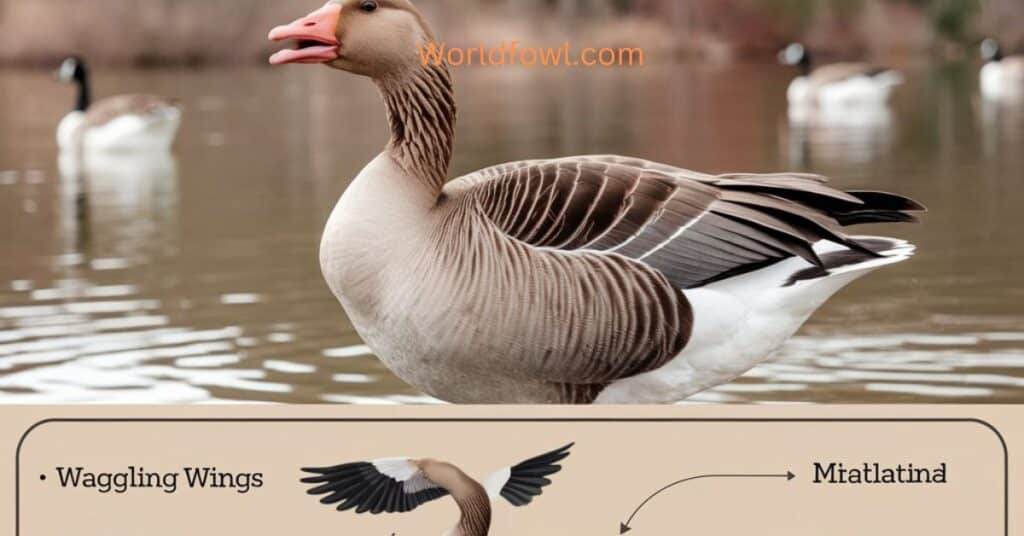
While honking is their most famous form of communication, geese have a rich repertoire of non-vocal signals as well.
Body Language: Wing Positions and Head Movements
Geese are expressive creatures, using their bodies to convey a wealth of information:
- Wing flapping: Can indicate aggression or readiness for flight
- Head bobbing: Often a prelude to attack or a sign of agitation
- Neck stretching: Used in threat displays or to signal alertness
Understanding these physical cues provides a more complete picture of goose communication. These body language signals are often used in conjunction with vocalizations to reinforce the message being conveyed.
you also like : Birds Similar To Cormorants – 5 Birds That Look Like Cormorants
Hissing: The Goose’s Way of Saying “Back Off”
When honking isn’t enough, geese resort to hissing:
- Defensive hiss: A warning to potential threats
- Aggressive hiss: Often accompanied by a forward lunge
- Nesting hiss: A protective sound made by nesting geese
This more intimate form of vocalization is typically reserved for close-range interactions and immediate threats. The hiss is a powerful deterrent, often used as a last warning before physical confrontation.
Silent Signals: Visual Cues in Flock Behavior
Not all goose communication is audible. Geese also rely on visual cues within the flock:
- Formation changes: Signaling shifts in direction or landing intentions
- Landing gear: The lowering of feet and necks indicates imminent landing
- Feeding postures: Alert other geese to good foraging spots
These silent signals complement the vocal and physical communications, creating a comprehensive language that governs goose society. The ability to communicate through these subtle visual cues is particularly important in noisy environments or when stealth is necessary.
The Impact of Environment on Goose Communication
As human activity reshapes the natural world, geese have had to adapt their communication strategies.
Urban Geese vs. Rural Geese: Adapting the Honk
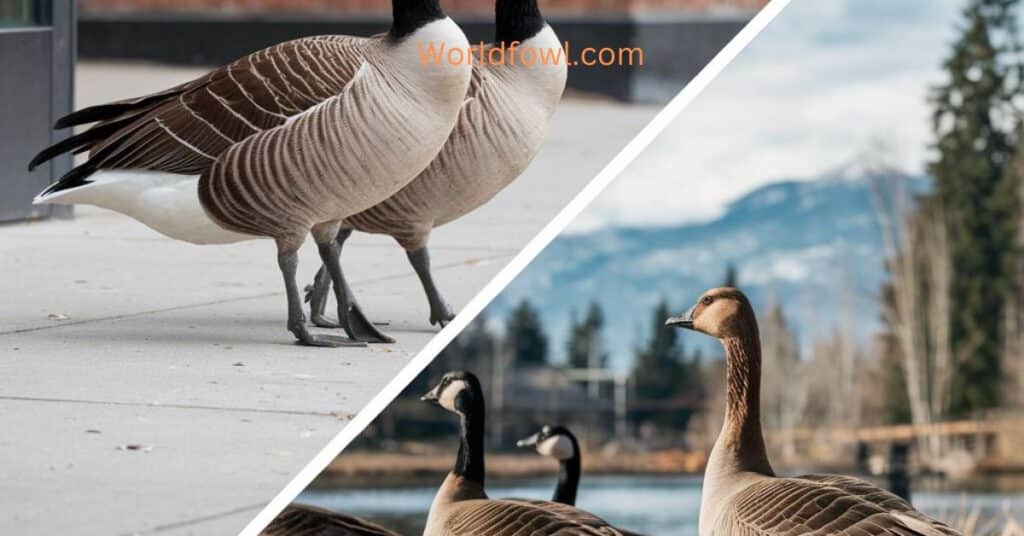
Geese living in urban environments face unique challenges:
- Noise pollution: Urban geese may honk louder or at different frequencies to be heard over city sounds
- Light pollution: Affects nighttime communication and navigation patterns
- Human interactions: More frequent defensive vocalizations in areas with high human traffic
These adaptations showcase the remarkable flexibility of goose communication in the face of environmental changes. Urban geese have been observed to be more vocal overall, possibly as a way to compensate for the increased visual obstructions in city environments.
How Climate Change Might Affect Migratory Patterns and Communication
The global climate crisis is having a profound impact on goose behavior:
- Altered migration timing: Changing when and how geese communicate during migration
- Shifting habitats: Forcing geese to adapt their calls to new environments
- Weather pattern changes: Affecting the need for and frequency of in-flight communication
As the climate continues to change, the vocalizations and behaviors of geese may serve as indicators of broader environmental shifts. Some goose populations are already showing changes in their migratory routes and timing, which in turn affects their communication patterns.
Goose Talk: Insights from Research and Technology
Modern science is shedding new light on the intricacies of goose communication.
Latest Studies on Goose Vocalizations
Recent research has revealed fascinating insights:
- Individual voice recognition among geese
- Dialectal variations in goose calls across different regions
- The role of early learning in developing vocal patterns
These findings highlight the complexity and sophistication of goose communication systems. Studies have shown that geese can recognize the calls of up to 100 individual flock members, demonstrating a level of social cognition previously underestimated.
Using Sound Recording Technology to Decode Geese Honk
Advanced audio technology is allowing researchers to analyze goose vocalizations in unprecedented detail:
| Technology | Application |
| Spectrograms | Visual representation of honk frequencies |
| Machine learning | Identifying individual geese by their calls |
| Acoustic tracking | Monitoring migratory patterns through vocalizations |
These technological advancements are opening new avenues for understanding and preserving goose populations. Researchers can now track entire flocks using acoustic signatures, providing valuable data on migration patterns and population dynamics.
The Cultural Significance of Geese Honk
The distinctive sound of honking geese has left an indelible mark on human culture and imagination.
Geese in Folklore and Literature
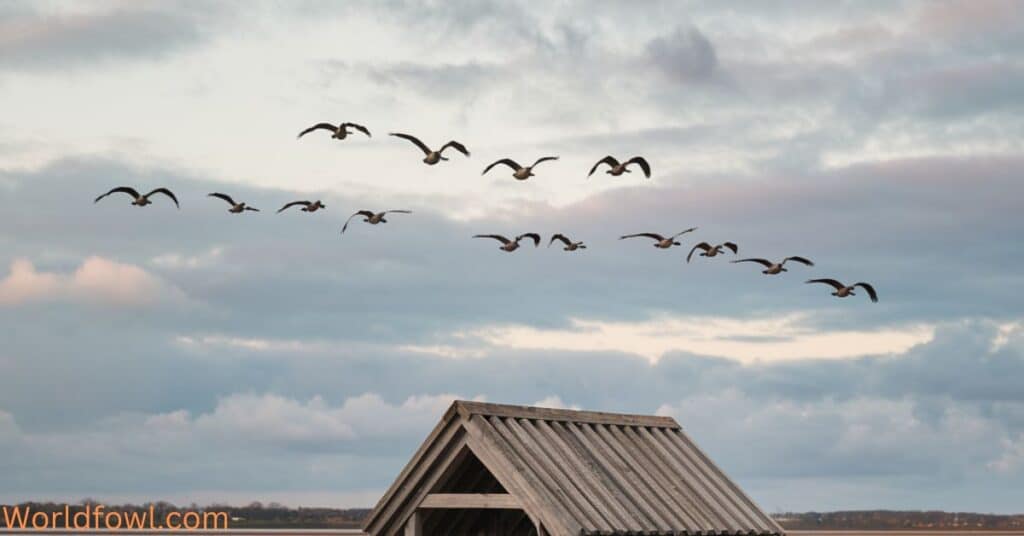
Across cultures, geese have played significant roles in stories and myths:
- Ancient Egypt: Geese were associated with the god of the earth and resurrection
- Aesop’s Fables: “The Golden Goose” teaches lessons about greed and kindness
- Hans Christian Andersen: “The Wild Swans” features geese as magical creatures
These cultural representations often draw on the mysterious and awe-inspiring nature of goose flight and vocalizations. The honking of geese has been interpreted as everything from omens of change to symbols of loyalty and teamwork.
you may like : What Do Magpies Eat? Magpie Diets Exposed
How Goose Behavior Has Influenced Human Activities
The behavior of geese, particularly their communication and navigation skills, has inspired human innovations:
- V-formation flying: Studied by aeronautical engineers for fuel-efficient flight patterns
- Honking patterns: Analyzed for insights into effective team communication
- Migratory instincts: Explored for developing more accurate navigation systems
From aviation to management theory, the humble goose continues to influence human thought and technology. The concept of “geese leadership,” where team members take turns leading based on the V-formation model, has gained popularity in organizational management.
Conservation and the Future of Goose Communication
As we unravel the mysteries of why geese honk, it becomes increasingly clear how vital it is to protect these remarkable birds and their habitats.
Protecting Migratory Routes and Habitats
Conservation efforts are crucial for preserving goose populations and their communication systems:
- Wetland preservation: Protecting critical stopover points during migration
- Noise reduction: Minimizing human-made sounds that interfere with goose communication
- Habitat connectivity: Ensuring geese can follow traditional migratory routes
These efforts not only protect geese but also preserve the intricate web of ecosystems they interact with during their journeys. The conservation of goose habitats has far-reaching benefits for biodiversity and ecological health.
The Role of Citizen Science in Understanding Goose Behavior
Everyday people are playing an increasingly important role in goose research:
- eBird: A platform for birdwatchers to report goose sightings and behaviors
- Acoustic monitoring programs: Volunteers helping to record and analyze goose calls
- Migration tracking: Citizen scientists assisting in tracking tagged geese
This collaborative approach to research is providing valuable data on goose populations and behavior patterns across vast geographic areas. The involvement of citizen scientists has dramatically increased the scale and scope of goose research, leading to new insights into their communication and migratory patterns.
The Complexity of Goose Social Structures
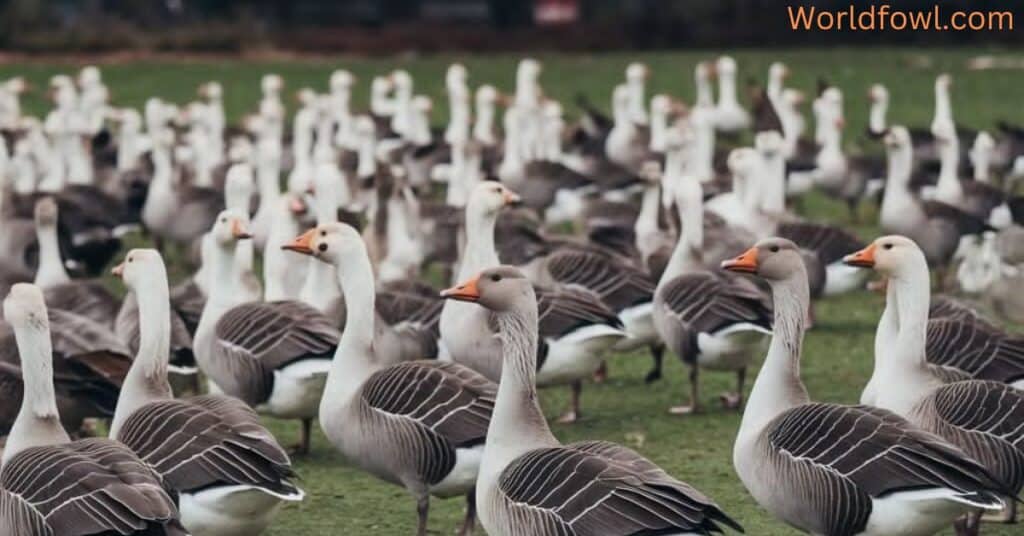
The sophisticated communication systems of geese reflect their complex social structures. Let’s delve deeper into the social world of these remarkable birds.
Family Bonds and Flock Dynamics
Geese are known for their strong family ties and intricate flock relationships:
- Lifelong pair bonds: Geese often mate for life, using vocalizations to maintain their bond
- Extended family groups: Multiple generations may travel and feed together
- Flock hierarchies: Established through a combination of vocalizations and physical displays
These social structures are maintained and reinforced through various forms of communication, with honking playing a central role in both family and flock interactions.
The Role of Honking in Conflict Resolution
Geese use vocalizations as a key tool in resolving disputes within the flock:
- Warning honks: To establish personal space and avoid physical confrontations
- Submission calls: Lower-pitched honks to de-escalate aggressive encounters
- Triumph calls: Celebratory honking after successful conflict resolution
This vocal conflict resolution system helps maintain flock cohesion and reduces the risk of injury from physical altercations.
The Future of Goose Communication Research
As our understanding of goose communication grows, new questions and research directions emerge:
Potential Areas for Future Study
- Impact of artificial light on nocturnal communication
- Effects of noise pollution on goose vocal development
- Role of ultraviolet vision in goose visual communication
- Potential use of infrasound in long-distance goose communication
These areas of research promise to further unveil the complexities of goose communication and behavior.
Implications for Wildlife Management and Conservation
Understanding goose communication has practical applications:
- Humane deterrent methods: Developing acoustic deterrents based on goose warning calls
- Habitat design: Creating environments that support natural goose communication patterns
- Population monitoring: Using acoustic surveys to estimate goose populations accurately
By applying our knowledge of goose communication, we can develop more effective and ethical wildlife management strategies.
Conclusion: The Enduring Mystery and Beauty of Goose Flight
As we’ve explored the many facets of why geese honk when they fly, we’ve uncovered a world of complexity and wonder. From the aerodynamics of their V-formation to the nuanced vocalizations that guide them across continents, geese demonstrate a level of sophistication that continues to amaze scientists and nature enthusiasts alike.
We’ve learned that the honking of geese serves multiple crucial functions:
- Maintaining flock cohesion during long flights
- Navigating across vast distances
- Warning of potential dangers
- Coordinating energy-efficient formations
- Strengthening social bonds within the flock
Yet, for all we’ve discovered, there remain questions to be answered and mysteries to be solved. The ongoing research into goose communication promises to reveal even more about these remarkable birds and their place in the natural world.
As you listen to the next flock of geese passing overhead, take a moment to appreciate the complexity behind their calls. Their honks are not just noise, but a symphony of survival, a testament to the ingenuity of nature, and a reminder of the intricate connections that bind all living things.
In understanding why geese honk, we gain not just knowledge about a specific behavior, but insight into the broader tapestry of life on Earth. It’s a call that echoes through time, linking us to the natural world and reminding us of the importance of preserving these magnificent creatures and the habitats they depend on.
So the next time you hear the honk of geese in flight, remember: you’re not just hearing noise, you’re listening to an ancient language, a sky-high symphony that has played out over our heads for millennia. It’s a sound that connects us to the rhythms of the natural world and the enduring mystery of animal communication.
As we continue to study and appreciate the complex world of goose communication, we open ourselves to a deeper understanding of the natural world and our place within it. The honking of geese is more than just a familiar sound of nature – it’s a window into a rich, complex world of animal behavior that continues to inspire and amaze us.

Henry James is a seasoned blogger and a passionate storyteller on “World Fowl.” With years of experience crafting engaging content, he brings a unique blend of expertise and creativity to his writing. Henry specializes in exploring diverse topics with depth and clarity, captivating readers worldwide.







